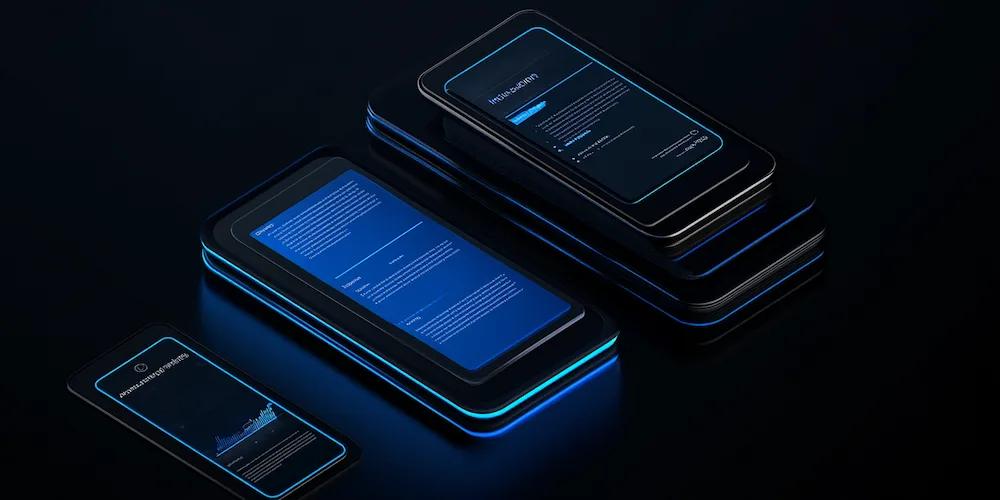Embarking on mobile UX design can be both challenging and rewarding, especially as mobile usage continues to dominate the digital landscape. This guide offers key insights and best practices to help product managers, designers, and business decision-makers create mobile-optimized digital experiences that align with modern usability standards. Whether you're aiming to boost user engagement or drive business growth, understanding these principles will equip you with the tools needed to succeed in a mobile-first world.
In brief:
- Mobile UX design is critical for enhancing user satisfaction and driving business growth in a mobile-first world.
- Core principles include designing for touch interaction, performance optimization, simplified navigation, visual clarity, and contextual design.
- Implementing user-centric design, effective testing methods, and staying ahead with future trends like AI personalization and AR/VR can lead to compelling mobile experiences.
- Addressing common challenges such as complex information architecture and performance issues is necessary for creating user-friendly mobile interfaces.

Introduction to Mobile UX Design
Mobile UX (User Experience) design is the strategic process of enhancing user satisfaction by improving the usability, accessibility, and pleasure in mobile interactions. It encompasses everything from visual design and interaction patterns to information architecture, all specifically tailored for mobile devices.
It is crucial across various sectors, including UX design in MedTech, where user-friendly mobile experiences can significantly impact patient engagement and healthcare outcomes.
As users increasingly rely on smartphones for browsing, shopping, and accessing services, they expect fast, intuitive, and engaging experiences. Poor mobile UX can lead to high bounce rates and lost conversions, while exceptional mobile experiences can provide a significant competitive advantage in a crowded marketplace.
5 Core Principles of Mobile UX Design
Mobile UX design requires a fundamentally different approach from desktop interfaces, driven by unique constraints and user behaviors. Here are the essential principles that will help you create effective mobile experiences:
1. Design for Touch-First Interaction
Design for fingers, not cursors. Make touch targets at least 44x44 pixels to prevent misclicks and provide comfortable interaction. Position important elements like navigation buttons and calls-to-action within easy thumb reach, typically in the lower portion of the screen.
2. Enhance Performance and Speed
Mobile users are significantly more impatient—they're five times more likely to abandon a site if it's not mobile-friendly. Identifying and improving website speed is essential. Optimize images, minimize code, and implement efficient loading strategies. For example, compressing images can significantly reduce load times, improving user satisfaction. Consider implementing offline capabilities for core functionalities to maintain usability even with poor connectivity.
3. Simplify Navigation
Reduce cognitive load by implementing clear, hierarchical navigation structures. Use familiar patterns like bottom navigation bars for apps or hamburger menus for content-heavy sites. Minimize the number of steps required to complete key tasks, as every extra tap increases the risk of abandonment. Implementing a bottom navigation bar with clear icons helps users access main features quickly without excessive scrolling or searching.
4. Achieve Visual Clarity
Embrace white space and clear visual hierarchies. Use high-contrast text and sufficient spacing between interactive elements. Break content into digestible chunks and use progressive disclosure to reveal information as needed, rather than overwhelming users with everything at once.
5. Apply Contextual Design
Consider the mobile context—users are often distracted, using the device one-handed, or in varying lighting conditions. For instance, incorporating larger buttons and avoiding small text can help users interacting while on the move. This is especially important in sectors like healthcare, where healthcare UX trends emphasize ease of use and accessibility for a wide range of users. Design interfaces that are forgiving of mistakes, provide clear feedback for actions, and maintain usability across different environmental conditions.
4 Essential Mobile UX Design Components
Your mobile interface needs specific, measurable components to deliver an optimal user experience. Utilizing effective UX design tools can help you implement these elements accurately. Let's break down the essential elements with their exact specifications and implementation guidelines.
1. Optimize Layout and Navigation
The foundation of your mobile interface should follow these precise specifications:
- Implement a minimum content margin of 16px from screen edges.
- Use a bottom navigation bar height of 56-64px for comfortable thumb reach.
- Structure primary navigation with 4-5 items maximum.
- Set hamburger menu icon size to at least 24x24px.
For grid layouts, maintain 8px spacing between elements to create visual harmony and proper element separation.
2. Establish Effective Touch Targets and Interaction
All interactive elements should meet these specific measurements:
- Buttons: Minimum size of 44x44px (iOS) or 48x48px (Android).
- Input fields: Height of 44-48px.
- List items: Minimum height of 44px with 16px padding.
- Spacing between clickable elements: Minimum 8px to prevent accidental taps.
3. Utilize Typography and Visual Elements
Follow these precise typography guidelines:
- Body text: 16px minimum for readability.
- Headlines: Scale from 20px to 32px maximum.
- Line height: 1.4-1.5 times the font size.
- Maximum line length: 60 characters per line.
For visual feedback, implement:
- Touch state animations lasting 200-300ms.
- Loading indicators appearing within 100ms of interaction.
- Progress bars for operations taking longer than 1 second.
4. Implement Performance Optimization
Optimize these technical aspects for smooth performance:
- Image sizes: Maximum 1MB for hero images, 200KB for thumbnails.
- Page load time: Target under 3 seconds on 4G connections.
- First Contentful Paint (FCP): Under 1.8 seconds.
- Cache essential assets for offline functionality.
Choosing the right CMS for mobile design can assist in efficiently managing your content and improving loading times.
Remember to test your interface across various devices and screen sizes, maintaining consistent spacing ratios and touch target sizes regardless of display dimensions. Using a responsive design checklist can help ensure your design adapts effectively to all screen sizes. Regular performance monitoring and optimization will ensure your mobile interface remains responsive and user-friendly.

4 Mobile UX Design Best Practices
To create compelling mobile experiences that drive user engagement and business growth, focus on implementing a solid UX design strategy that aligns with user expectations and business goals. Here's how to execute mobile UX design effectively:
1. Implement User-Centric Design
Start by conducting thorough user research to understand your audience's needs and behaviors. Create detailed personas and user scenarios to guide your design decisions. Incorporating effective personalization strategies can further enhance user engagement by tailoring the experience to individual users. For instance, if your app targets busy professionals, prioritize quick actions and efficient workflows.
When implementing the interface, maintain simplicity as your guiding principle. Remove unnecessary elements and use white space strategically to improve readability and focus. Keep your design language consistent throughout the app, using the same colors, fonts, and button styles to build familiarity.
2. Optimize Navigation and Interaction
Design touch targets that are easily tappable—aim for a minimum size of 44x44 pixels to prevent misclicks and user frustration. Implement intuitive navigation patterns that users are already familiar with, such as bottom navigation bars for primary actions, hamburger menus for secondary features, and clear search functionality for content-heavy apps.
Provide immediate feedback for all user actions. When a button is pressed or a form is submitted, users should receive visual confirmation that their action was successful.
3. Enhance Performance and Accessibility
Optimize your app's performance by minimizing code and compressing assets, implementing efficient caching strategies, and considering offline functionality for critical features. Understanding the differences between headless vs traditional CMS can help you make informed decisions about your content management and delivery, impacting the overall performance of your mobile experience.
Make your app accessible to all users by following these guidelines: maintain proper color contrast ratios, include alt text for images, support screen readers, and design with various disabilities in mind. Adhering to accessibility best practicesensures your mobile experience is usable by the widest possible audience.
4. Embrace Testing and Iteration
Use interactive prototypes to test your designs before development. Interactive prototyping tools can help simulate the user experience effectively. Conduct regular usability testing with real users and gather feedback through A/B testing of new features, user behavior tracking, heat maps and click tracking, and customer satisfaction surveys.
Monitor key performance indicators (KPIs) specific to mobile experiences, such as engagement rates, conversion rates, and user satisfaction scores. Use this data to make informed decisions about design improvements and feature prioritization.
Remember to foster collaboration between your product, design, and development teams throughout the process. This cross-functional approach aligns design decisions with technical capabilities and business objectives while maintaining focus on user needs.
Testing and Optimization
Testing your mobile UX design is critical for verifying its effectiveness and continuously improving the user experience. You'll need to implement a combination of testing methods to gather comprehensive insights about your design's performance.
Adopt Key Testing Methods
Start with usability testing by having users complete key tasks on your mobile interface while thinking aloud. This approach provides direct insights into how users interact with your design and where they encounter difficulties. Complement this with A/B testing to compare different design variations and make data-driven decisions about elements like button placements, navigation patterns, or content layouts.
Five-second testing helps evaluate users' first impressions of your mobile interface, which is particularly important given the quick decision-making nature of mobile users. This method involves showing users your design for just five seconds and gathering their immediate reactions and recall.
Use Tools for Implementation
Several tools can streamline your testing process. Use remote usability testing platforms that allow you to reach users across different locations and devices. These tools provide features for creating task scenarios, collecting user feedback, and analyzing results.
For A/B testing, implement testing frameworks that specifically support mobile interfaces. Track key metrics like tap accuracy, scroll patterns, and task completion rates to measure the success of different design variations.
Analyze and Iterate
Document all testing results thoroughly and look for patterns in user behavior and feedback. Create a systematic approach to analyzing this data:
- Identify common pain points across multiple users.
- Prioritize issues based on impact and frequency.
- Develop specific solutions for each identified problem.
- Implement changes iteratively, testing each significant modification.
Remember that testing isn't a one-time effort but an ongoing process. Establish regular testing cycles to continuously gather feedback and optimize your mobile UX design based on real user data and behavior patterns.
Common Mobile UX Design Challenges and Solutions
Creating effective mobile experiences presents unique challenges that require thoughtful solutions. Here are the most critical mobile UX design challenges and how to overcome them:
Overcome Complex Information Architecture
Mobile screens demand efficient organization of complex information. Implement progressive disclosure techniques to reveal information gradually, and use clear visual hierarchies to guide users through content. For instance, using expandable sections or accordions can help present information without overwhelming the user.
Master Touch Interaction Design
Mobile interfaces must accommodate various hand sizes and usage patterns. Design touch targets with a minimum size of 44x44 pixels to provide reliable interaction. Position important actions within thumb-friendly zones and implement gesture-based interactions that feel natural on mobile devices.
Address Performance and Connectivity Issues
Users often access mobile applications in conditions with limited connectivity. Optimize your mobile experience by implementing offline capabilities and efficient loading strategies. For example, a news app might cache recent articles so users can read them even when offline. Consider using skeleton screens during loading states and caching critical data for offline access.
Utilize Responsive Visualization
Presenting complex data on small screens requires careful consideration. Use responsive design patterns that adapt to screen size while maintaining data clarity. Implement interactive elements that allow users to explore data through natural touch gestures, such as pinch-to-zoom or swipe-to-scroll through datasets. For example, financial apps often present charts that users can zoom into for detailed views.
Future Trends in Mobile UX Design
The mobile UX landscape is rapidly evolving, driven by technological advances and changing user behaviors. With over 90% of internet users accessing the web via mobile devices, understanding and keeping up with the latest UX design trends is critical for fast-growing tech companies.
Voice interfaces are becoming a primary interaction method, with voice assistant adoption expected to reach nearly half the US population by 2026. For tech companies, this means integrating Voice User Interfaces (VUIs) into mobile applications to provide hands-free operation and enhanced accessibility.
Immersive experiences through AR and VR are gaining momentum, with mobile AR users projected to reach 1.73 billion by 2024. Tech companies should consider implementing AR features for product visualization and interactive tutorials to enhance user engagement.
AI-powered personalization is revolutionizing mobile experiences through adaptive interfaces and real-time customization based on user behavior. Learning to effectively leverage AI in UX design can significantly improve user engagement and retention. Implementing machine learning algorithms and utilizing AI in headless CMS for content delivery and interface adaptation can also drive personalization efforts.
Accessibility is becoming non-negotiable, with increased focus on inclusive design practices. Companies should prioritize features like screen reader compatibility, proper contrast ratios, and adaptable text sizes to make their mobile experiences accessible to all users.
Microinteractions and dark mode options are emerging as key elements of modern mobile design, improving user feedback and reducing eye strain while maintaining engagement through subtle, meaningful animations. Staying updated on modern design trends can help your mobile UX stay ahead of the curve.
Conclusion
Mobile UX design is a cornerstone of digital success, not just a passing trend. Applying user-centric design principles, optimizing performance, and conducting consistent testing can help you create mobile experiences that truly resonate with your audience. Investing in mobile UX goes beyond aesthetics—it directly impacts user satisfaction, engagement, and ultimately, your competitive edge in the digital landscape.
As mobile usage continues to dominate, implementing these best practices is necessary for staying relevant and driving growth. Start applying these principles today to transform your mobile experience into a powerful asset for your business's future.
Ready to optimize your SaaS website structure for growth? See the Webstacks difference:_ Schedule a brief discovery call today_. Let us help you create a website that drives results.





